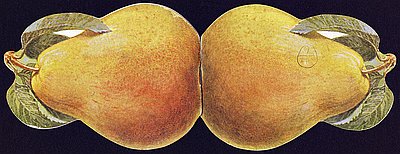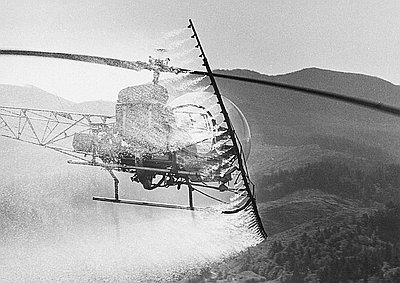- Catalog No. —
- OrHi 104310
- Date —
- c. 1930
- Era —
- 1921-1949 (Great Depression and World War II)
- Themes —
- Agriculture and Ranching, Environment and Natural Resources, Trade, Business, Industry, and the Economy, Transportation and Communication
- Credits —
- Oregon Historical Society
- Regions —
- Columbia River Willamette Basin
- Author —
- Pacific Northwest Electric Railway Association
Spraying Orchard, Hood River
This ca. 1930 photograph shows a Hood River orchardist and child spraying pear or apple trees. The photograph is from the Pacific Northwest Electric Railway Association collection at the Oregon Historical Society. A railroad company may have used this image to promote immigration into the Hood River Valley.
In the early 20th century, an increasing number of American farmers began to use chemical sprays against fungal diseases and insects. One of the earlier commercial products was Paris green, an arsenic-laced pigment that had previously been marketed as paint.
In Oregon, the state board of horticulture encouraged orchardists to use a variety of arsenic and copper solutions, lead arsenate, and lime sulfur to prevent damage from coddling moths, aphids, pear fruit worms, red spider mites, and fungal canker diseases. In the 1920s, people became aware of the health dangers from arsenic and lead arsenate residues. European countries negotiated international trade regulations limiting the allowable amount of chemicals residue on fruit and vegetable exports. In Oregon, the board of horticulture responded by requiring farmers to clean their export products in hydrochloric acid.
By the 1940s, chemists developed a number of synthetic organic pesticides, including dichlorodiphenyltrichloroethane (DDT). In 1962, Rachel Carson’s book Silent Spring raised awareness about the damaging effects of DDT and other pesticides to humans and the environment. The U.S. Environmental Protection Agency banned DDT in 1972.
Written by Kathy Tucker, © Oregon Historical Society, 2002.
Related Historical Records
-
Promotional Pamphlet for Oregon Orchards
In the 1920s, the Medford and Ashland commercial clubs produced this pamphlet to attract more people to Jackson County. The pamphlet extolled the climate and orchards of the …

-
Helicopter Sprays Chemical Herbicide
This photograph, by Dana Olsen, originally appeared on the front page of the Oregon Journal as an illustration for an article titled, “Miscarriages Bring Herbicide Ban.” The unprecedented …

-
Crating Apples in Hood River
This photograph, which shows workers packing apples into boxes, is identified by a hand-written note on the back as being “probably Hood River.” The photographer either was Benjamin …

